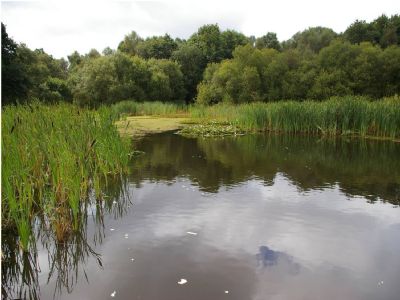
Yateley Common is a very important heathland of which there are diminishing numbers worldwide. In order to preserve the heathland habitat it is necessary regularly to remove large areas of scrub and trees. After clearing an area it is often necessary to scrape off the nutrient rich layer of top soil. Being adapted to poor soils, heather finds it difficult to compete with other plants when soil conditions improve. Once an area has been scraped the heather can naturally regenerate from the seeds remaining in the soil.
The areas of heathland primarily consist of three types of heather- Ling, Bell Heather and Cross Leaved Heath, along with Common and Dwarf Gorse.As well as working to preserve the heathland, we also aim to maintain a variety of habitats and vegetation structures such as woodland, scrub, scattered trees and grassland. This enables a wide diversity of wildlife to survive and is important for species that use more than one habitat during their lifecycle or daily activities. Some species are especially reliant upon the boundaries between habitat types.If invasive species such as Rhododendron become established every effort is made to remove and eradicate them before they out compete the native wildlife.
The wide variety of habitats on Yateley Common Country Park makes it suitable for a range of wildlife. These areas support a variety of specialised heathland wildlife including a number of breeding birds of European importance, including Nightjars, Dartford Warblers and Stonechats. Being warm and sandy, the heathland on the Common makes an ideal home for a number of insects and reptiles, including the Heath Potter Wasp, the Viviparous Lizard (right) and Adders. The Common also supports a variety of butterflies such as the Silver Studded Blue and the Grayling.
A number of interesting flowers such as Bee Orchids and Carline Thistle can be found on the grassland areas to the west of the site. In spring Bluebells and Wood Anemones carpet old wooded hedge banks, whilst the distinctive song of the Nightingale is commonly heard alongside more common species such as the Garden Warbler and Chaffinch.
Golden Ragwort is a very abundant common weed with golden yellow petals. It produces a natural pesticide (of the alkaloid family) which is toxic to cattle and dogs when in flower. It is a notifiable weed because Cattle are prone to eat it. Uprooting is the best way to eradicate it.
The ponds and lakes on the Common are particularly important for a number of scarce dragonflies and damselflies, including the Black Darter and Downy Emerald. Six species of nationally notable water beetles have also been found. Nightjars come from Southern Sahara to nest and lay their eggs which is a journey of about 3000mls.

